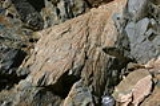
Santa Fe impact structure
Encyclopedia
The Santa Fe impact structure is an eroded remnant of a bolide impact crater in the Sangre de Cristo Mountains
northeast of Santa Fe, New Mexico
. The discovery was made in 2005 by a geologist who noticed shatter cones in the rocks in a decades-old road cut
on New Mexico State Highway 475 between Santa Fe and Hyde Memorial State Park
. Shatter cones are a definitive indicator that the rocks had been exposed to a shock of pressures only possible in a meteor impact or a nuclear explosion.
It is called an "impact structure
" and not a crater
because it is so deeply eroded. Current estimates place the age of the impact between 1.4 and 1.6 billion years. Only the crater's basement rocks remain on the surface in the mountains today. The estimated diameter of the structure is currently a subject of study. The shatter cones occur for about 1 mile (1.6 km) along the highway, which is interpreted to coincide with a central area within a crater of greater diameter.
Sangre de Cristo Mountains
The Sangre de Cristo Mountains are the southernmost subrange of the Rocky Mountains. They are located in southern Colorado and northern New Mexico in the United States...
northeast of Santa Fe, New Mexico
Santa Fe, New Mexico
Santa Fe is the capital of the U.S. state of New Mexico. It is the fourth-largest city in the state and is the seat of . Santa Fe had a population of 67,947 in the 2010 census...
. The discovery was made in 2005 by a geologist who noticed shatter cones in the rocks in a decades-old road cut
Cut (earthmoving)
In civil engineering, a cut or cutting is where soil or rock material from a hill or mountain is cut out to make way for a canal, road or railway line....
on New Mexico State Highway 475 between Santa Fe and Hyde Memorial State Park
Hyde Memorial State Park
Hyde Memorial State Park is a state park of New Mexico, USA, located northeast of Santa Fe in the Sangre de Cristo Mountains. Summertime activities include hiking and camping, and in the winter the park is popular for tubing on the snow-covered hillsides....
. Shatter cones are a definitive indicator that the rocks had been exposed to a shock of pressures only possible in a meteor impact or a nuclear explosion.
It is called an "impact structure
Impact structure
The term impact structure is closely related to the terms impact crater or meteorite impact crater, and is used in cases where erosion or burial have destroyed or masked the original topographic feature with which we normally associate the term crater...
" and not a crater
Impact crater
In the broadest sense, the term impact crater can be applied to any depression, natural or manmade, resulting from the high velocity impact of a projectile with a larger body...
because it is so deeply eroded. Current estimates place the age of the impact between 1.4 and 1.6 billion years. Only the crater's basement rocks remain on the surface in the mountains today. The estimated diameter of the structure is currently a subject of study. The shatter cones occur for about 1 mile (1.6 km) along the highway, which is interpreted to coincide with a central area within a crater of greater diameter.

